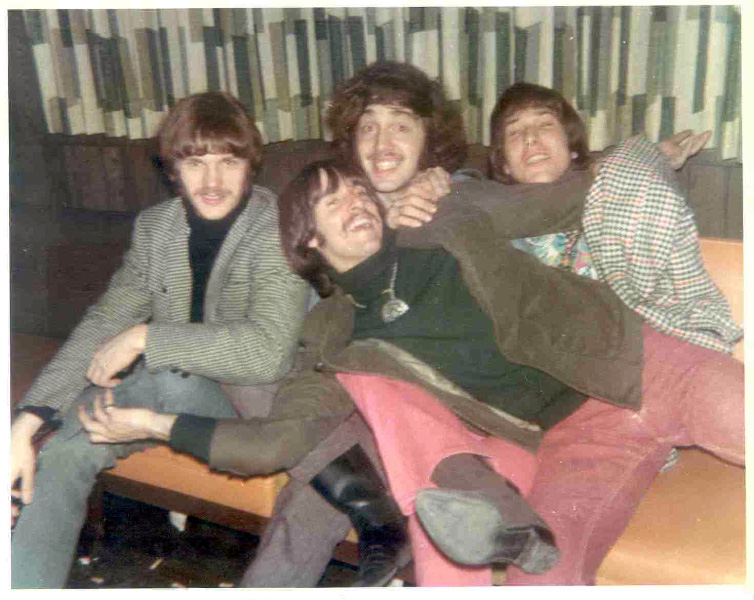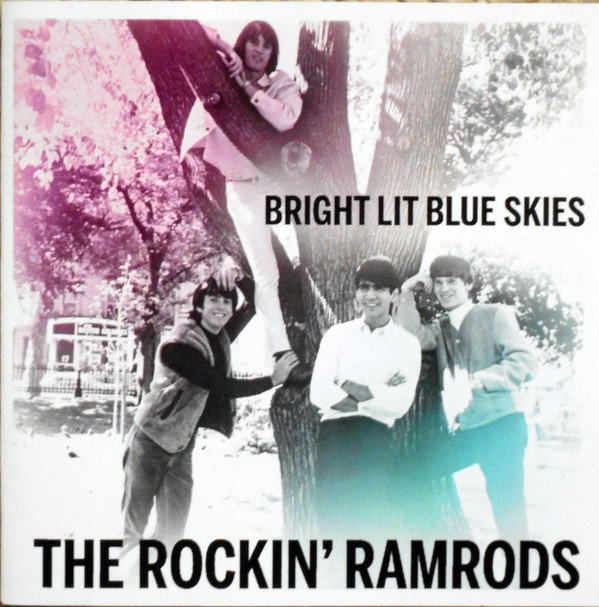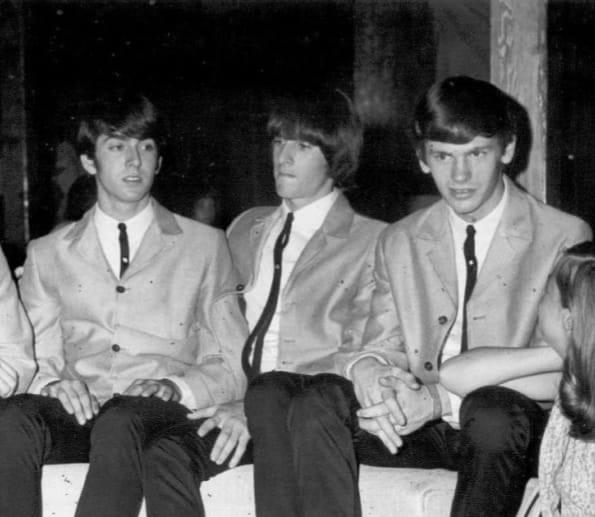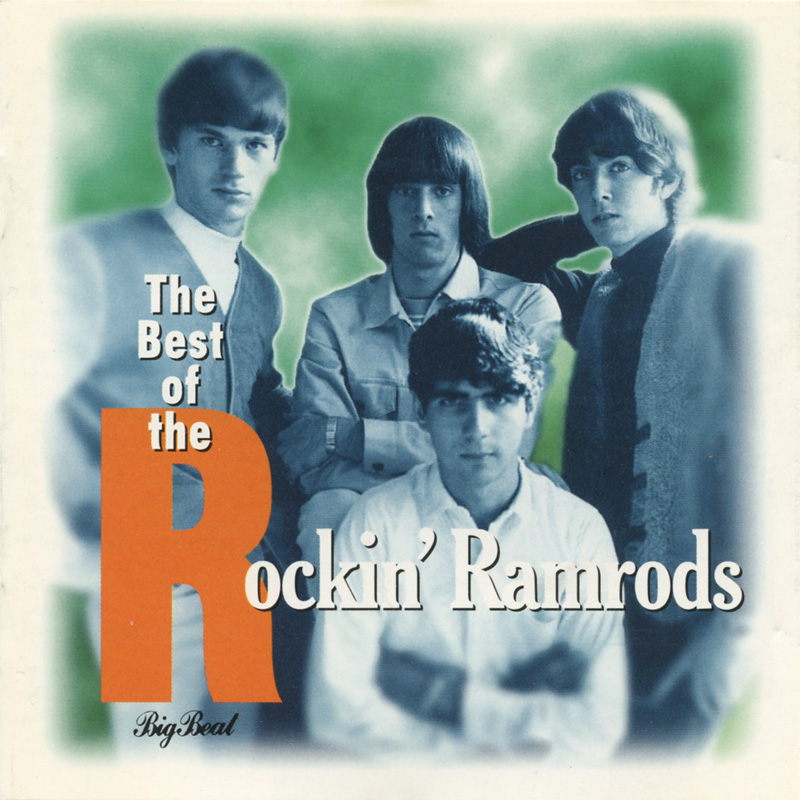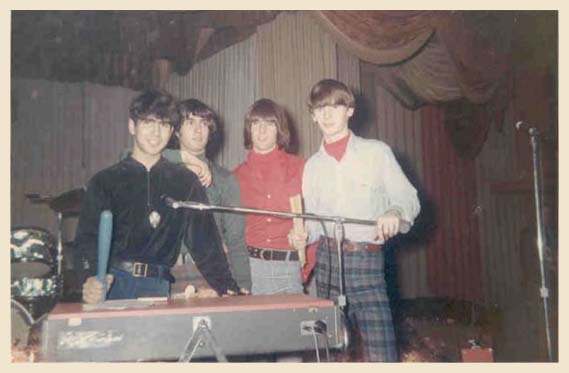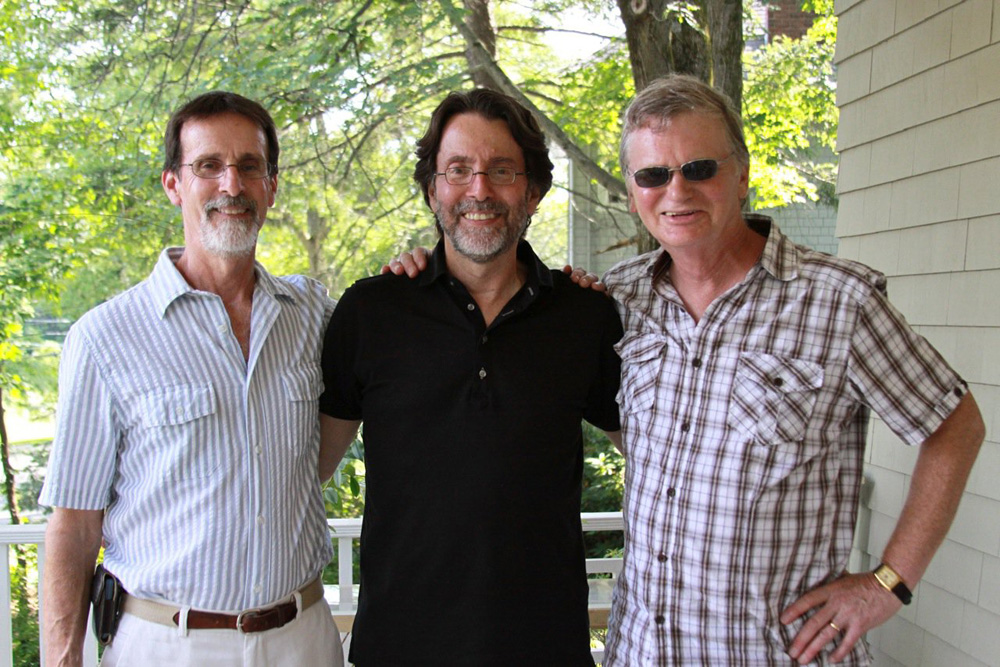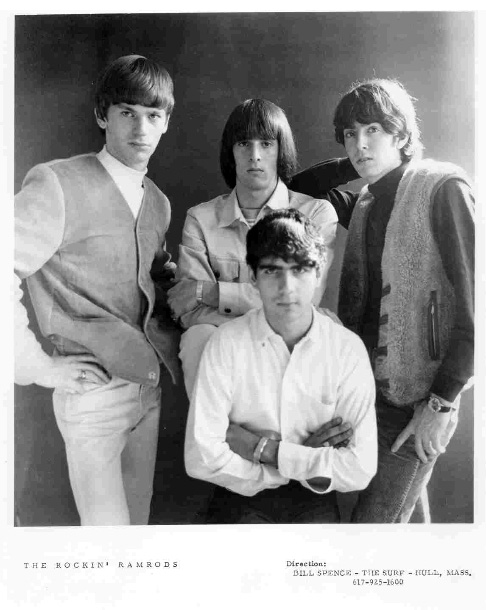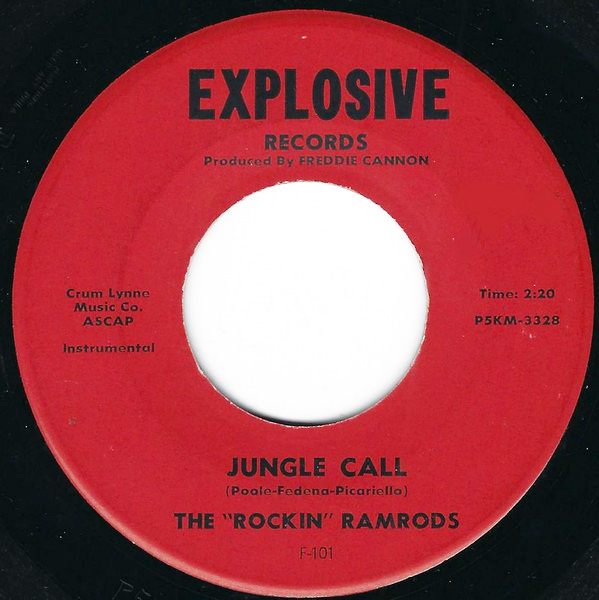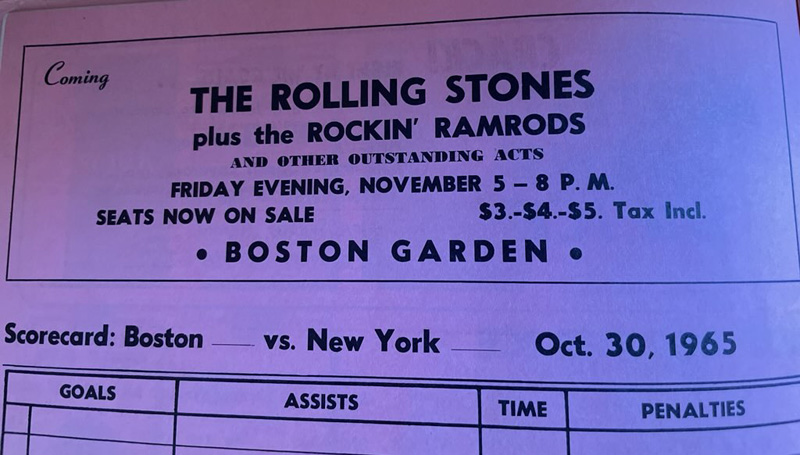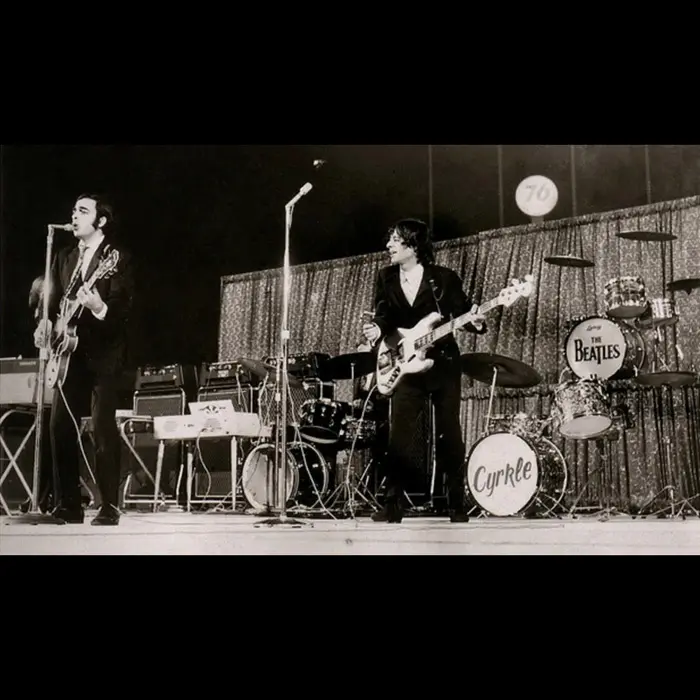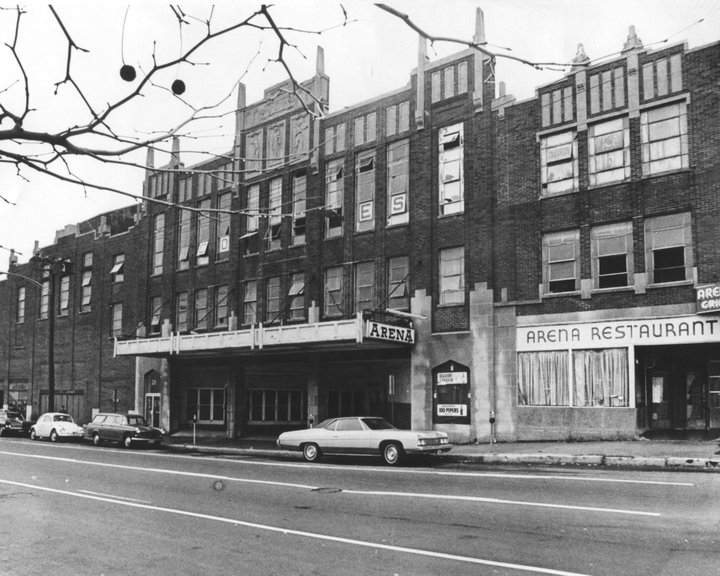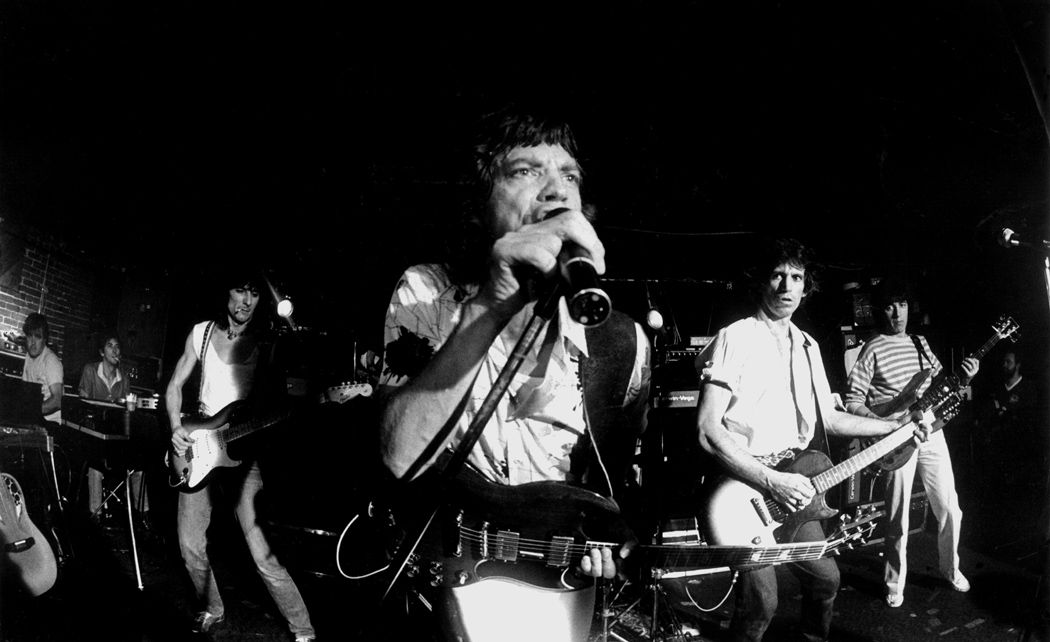The Rockin’ Ramrods

Like all major American cities, Boston was overflowing with garage bands in the mid-‘60s, largely the result of The Beatles‘ debut on The Ed Sullivan Show in February 1964 and the ensuing rock ‘n’ roll tsunami called the British Invasion. And when it came to the most crowd-thrillin’, distortion-laden, keester-kickin’ acts in the city, there was a widely recognized triumvirate: The Remains, The Lost and The Rockin’ Ramrods.
But the Ramrods were the granddaddy of the three, having formed some two years before the Fab Four’s appearance on the Sullivan show; The Lost and The Remains formed in the months after that seminal broadcast, the former at Goddard College and the latter at Boston University. By the time those bands landed their first gigs, the Ramrods were a mainstay on Boston’s AM airwaves, playing to packed houses at the Surf Ballrooms north and south of the city, boasted a fan club of some 2,500 and had opened for major acts including The Ventures.
As testimony to what heartthrobs they were, at the 1964 Gilchrist Fashion Hop at the Orpheum Theatre, the printed program included these results from a popularity questionnaire: “When we polled a number of high school girls for their choice of favorite local band, The Rockin’ Ramrods was their unanimous choice,” it read, according to Charles William White III in an article published in The Beat in 1985. Though they never broke through nationwide – neither did The Lost and The Remains – The Rockin’ Ramrods were essentially The Beatles of Boston long before most people knew that “Beatles” was spelled with an “a,” not with a double “e.”
FORMATION, MANAGEMENT, THE SURF
The group was formed in 1962 as The Ramrods Four by Boston native Bill Linnane (lead guitar, keyboards), West Newton native Vin Campisi (rhythm guitar), Bob Blake (bass) and Butch Holmes (drums), all teenagers at the time. They started out as an instrumental surf-rock unit, as did hundreds of other bands across the US, swept up by the tornado generated by Quincy native Dick Dale’s 1961 single “Let’s Go Trippin’” and his 1962 album Surfer’s Choice.
In 1963, Campisi’s younger brother Ronn replaced Blake on bass and Bobby “Jesse” Henderson replaced Holmes on drums. That year, as instrumental rock fell out of fashion, the band changed their name to The Rockin’ Ramrods and Ronn took on lead-vocal duties. Vin and Henderson sang back-up while Linnane’s axe skills propelled the group’s scrappy, hard-edged protopunk sound.
The Ramrods’ manager was Bill Spence, owner of the Surf Ballroom chain, so they were frequent headliners at its three locations – Hyannis, Salisbury and Nantasket Beach in Hull – in addition to other New England clubs, high schools, colleges and universities. In the mid-‘60s, they opened for a laundry list of American and British acts including The Lovin’ Spoonful, The Dave Clark Five, The Rascals, Tommy James & The Shondells and The Doors.
FIRST SINGLES
The Rockin’ Ramrods recorded eight 45s in total, their first being “Jungle Call” b/w “Indian Giver,” issued in late 1963 on Explosive Records. In April 1964, two months after The Beatles’ landmark American TV appearance, they cut their Dave Clark Five-esque classic “She Lied,” written by Linane and Ronn Campisi, b/w “The Girl Can’t Help It,” a Little Richard tune from the 1956 film of the same name.
Released by Bon-Bon Records, “She Lied” and “The Girl Can’t Help It” were produced by Lynn, Massachusetts-raised Freddy Cannon, who put Boston on the global rock ‘n’ roll map when his debut LP, 1960’s The Explosive Freddy Cannon, became the first disc classified as “rock” to hit #1 in the UK charts (three years before The Beatles’ first album, Please Please Me, went to the top spot).
LATER SINGLES
In December 1964, the Ramrods cut Lennon-McCartney’s “I Wanna Be Your Man” b/w a little-known song from the Fab Four tunesmiths, “I’ll Be on My Way,” issued by Plymouth Records in January 1965. The group’s other five singles were “Wild About You” b/w “Cry in My Room” (Southern Sound, July 1965); “Don’t Fool with Fu Manchu” b/w “Tears Melt the Stones” (as The GTO’s, Claridge, November 1965); “Play It” b/w “Got My Mojo Workin'” (Claridge, April 1966); “Bright Lit Blues Skies” b/w “Mister Wind” (Plymouth, July 1966); and “Flowers in My Mind” b/w “Mary, Mary” (Plymouth, 1967). “Bright Lit Blue Skies” was their highest-charting tune, peaking at #16 on Boston’s WMEX.
CHANGING SOUND, TOURING WITH THE KINGSMEN
In the spring of 1965, the Ramrods signed a management contract with Frank Slay Jr., co-producer of The Explosive Freddy Cannon, and Linnae left the band, replaced by pianist-organist Scott Curtis, a Scituate, Massachusetts, native who also contributed vocals. The group’s sound changed dramatically – from a distorted, six-string-centric one to a smooth, organ-softened one – and Slay provided many of their new songs in an effort to catapult the group into the mainstream.
In the summer of 1965, they toured across the US with The Kingsmen, whose rendition of “Louie Louie” had reached #2 in Billboard Hot 100 in 1963. During the tour, Curtis disappeared unannounced and The Ramrods played three shows as a trio before bringing in keyboardist Lenny Cirelli, who became Curtis’ permanent replacement.
TOURING WITH THE ROLLING STONES
In the fall of 1965, the group landed the gig of a lifetime: opening for The Rolling Stones on the band’s six-week, 31-city North American tour (along with two other openers, Patti LaBelle and Her Blue Belles and The Vibrations). It was the Stones’ fourth US tour – after summer and fall ones in 1964 and one in the spring of 1965 – and their song “(I Can’t Get No) Satisfaction,” released four months before the tour began, had soared to #1 in the US, UK, Australia, South Africa and seven European countries. Dates included Boston Garden, Rhode Island Auditorium and New Haven Arena and the Ramrods often acted as decoys to help the Stones avoid screaming fans while entering and exiting venues.
Following their cross-continental journey with one of the two biggest bands on Earth, The Boston Herald Traveler asked Ronn Campisi for his thoughts. “After the first week, I don’t remember much,” he said. “You become disoriented. Sleep, wake up, play a gig, get on a plane.” Asked what the members of the Stones were like, Campisi told the reporter that he didn’t spend much time with the band’s own version of Lennon and McCartney. “Mick and Keith were more aloof than the rest,” he said. “The only time we saw them was on the plane. They kept more to themselves.”
After the Stones tour, Ronn and Lenny Cirelli left the band; the former was replaced by David-Allen Ryan (who joined Sha Na Na in 1973) and the latter by keyboardist-flutist Jim Mandell.
DISK-O-TEK HOLIDAY
In 1966, the Ramrods appeared in the film Disk-o-Tek Holiday backing Freddy Cannon and performing their song “Play It.” In the scene with Cannon, which is set at The Surf Ballroom in Nantasket, Arnie “Woo Woo” Ginsburg introduces the star (on a mic showing the call letters WMEX), who sings three of his best-known tunes, “Tallahassee Lassie,” “Transistor Sister” and “Buzz Buzz A-Diddle-It,” as an audience of teens dances away near the stage. Ginsburg does not introduce the group, but “The Rockin’ Ramrods” is clearly visible on the front of Henderson’s bass drum.
PUFF, ’71, DISBANDING
In 1966, the band shortened their name to The Ramrods and in 1968, after signing with MGM and Bosstown Sound promotor Alan Lorber, they cut an album under a new name, Puff. The self-titled LP, for which Ronn wrote all 12 tracks (even though he didn’t play or sing on the LP), had a totally different sound than previous releases: soft, psychedelic and experimental with jazz, blues and classical themes, much like that of another of Lorber’s “Bosstown” acts, Ultimate Spinach. Issued in early 1969, it was a commercial dud and the band reverted to the name The Rockin’ Ramrods. Mandell left the group and was replaced by Danny McBride.
In early 1971, Ronn put together a revised lineup for the sole purpose of recording – Vin Campisi, Danny McBride, guitarist Glenn Jordan and drummer Stu Kassner – and, with Bob (Jesse) Henderson as the engineer, the group recorded one self-released album, ’71, at Aengus Studios. By the fall of 1971, the band members had gone their separate ways.
POST-RAMRODS ACTIVITY, COMPILATIONS
Following the Ramrods’ split, Ronn Campisi became the art director of the Cambridge-based alternative weekly The Real Paper, then The Boston Globe. Vin Campisi joined Warner Bros. as West Coast operations manager, Lenny Cirelli worked in a major department store and Bill Linnan established a career in computer graphics at Lincoln Laboratories. Bob (Jesse) Henderson was the chief engineer at Long View Farm Studio until his death in 2022.
A number of compilations have been issued over the past 40 years, including I Wanna Be Your Man (Eva Records, 1983); The Best Of The Rockin’ Ramrods (Big Beat Records, 1995); The Best of the Rockin’ Ramrods (Akarma Records, 2000); The Rockin’ Ramrods (St. John’s Wood, 2004); Complete Single Recordings (Rock-In-Beat Records, 2009); Bright Lit Blue Skies (Iris Music Group, 2010); Best (Iris Music Group, 2011); and The Rockin’ Ramrods (BeatRocket, 2019).
LEGACY
In 2014, in a piece titled “The 101 Strangest Records on Spotify: Rockin’ Ramrods – ‘She Lied,’” The Guardian’s Rob Fitzpatrick wrote that the band was ahead of its time, calling them “punk before punk” and citing “She Lied” as an example of how the Ramrods were “rougher than a badger’s arse.” For those New Englanders who find themselves confused by such a thoroughly Old England sort of expression, it’s a wicked big compliment.
“’She Lied’ is a truly spectacular piece of protopunk, the sort of perfect blend of melody and aggression that The Ramones would go on to transform the planet with a dozen or more years later,” he wrote. “But this was not some troupe of sociopathic knuckle-draggers; The Rockin’ Ramrods were the sort of group who found themselves gainfully employed playing record hops in local department stores where the entrance fee was the cap from a Coke bottle. And yet, just listen to that track again – buzzsaw guitar, sloppy, slung-low bass, chanted vocals. The Rockin’ Ramrods are rougher than a badger’s arse, yet beautiful pop at the same time.”
Fitzpatrick went on to assert that producer Frank Slay Jr.’s feeding The Rockin’ Ramrods with poppy, mainstream material starting in 1965 was a waste of the band’s unique talent: creating breathtaking beauty out of dissonance and sheer volume. “Out went the thrash and in came the shapely pop gems,” he wrote. “Trouble is, a million people were making shapely pop gems in 1965 while almost no one was making a thrashy racket. Just imagine what [The Rockin’ Ramrods] could have done if someone [i.e., a producer] had been there to make their punk-before-punk vision a fully fleshed-out reality.”
(by D.S. Monahan)

